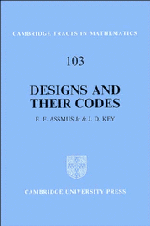8 - Steiner systems
Published online by Cambridge University Press: 05 October 2015
Summary
Introduction
Steiner systems are t-(v, &, λ) designs with λ = 1 and t > 2. Thus, every t-subset must reside in a unique block of the design. Such systems were of great interest in the early, recreational period leading up to Steiner's "Combinatorische Aufgabe” [268]; in general they are not easy to find. For t = 2 and 3, however, there are many infinite classes of such designs, some of which we have already encountered in earlier chapters, but for t — 4 and 5 only a finite number are known. None have been constructed for t > 6 and the question of the existence, or not, of Steiner systems for large values of t remains an open problem in design theory. In fact, even for general λ there were only a finite number of 5-designs known until Alltop [2] in 1972 produced an infinite class.
The question of the existence of non-trivial t-designs for general λ and t > 6 was, at one time, linked with the Schreier conjecture — that the only finite 6-transitive permutation groups are the alternating or symmetric groups. This conjecture has since been proved using the classification theorem for finite simple groups. In fact, it had been suggested in 1965 that a proof of the Schreier conjecture might be obtained by showing that there were no non-trivial ∧-designs for t > 6: see Hughes [142]. However, in 1983, Magliveras and Leavitt [205] found a 6-design (with λ = 36); a few years later Teirlinck [271] showed that non-trivial ∧-designs exist for all values of t. As far as we know there is not yet any direct proof of the Schreier conjecture and, of course, Teirlinck's result seems to indicate that design theory will be of little help in finding a direct proof.
A curious, and as yet unexplained, phenomenon is that although coding theory did play a role in uncovering new 5-designs (see Assmus and Mattson [18] or Pless [237]) it seems to be of little help in finding or treating t designs for t > 6. Roughly speaking, powerful group-theoretical methods did most of the discovering and classification of designs in the early stages of the theory. Coding-theoretical methods — those that we have discussed, which are, essentially, linear-algebraic — have extended and deepened the understanding of designs, but yet the best existence theorems seem to be of a recursive and set-theoretical nature.
- Type
- Chapter
- Information
- Designs and their Codes , pp. 295 - 316Publisher: Cambridge University PressPrint publication year: 1992
- 1
- Cited by



